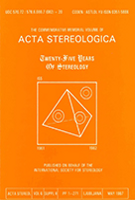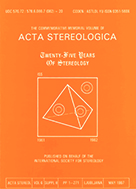- Accueil
- Volume 17 (1998)
- Number 1 - June 1998
- An observer-independent cytoarchitectonic mapping of the human cortex using a stereological approach
Visualisation(s): 835 (2 ULiège)
Téléchargement(s): 217 (1 ULiège)
An observer-independent cytoarchitectonic mapping of the human cortex using a stereological approach

Abstract
Cytoarchitectonic areas of the cerebral cortex cannot be identified in PET or fMRI images. Architectonic identification, however, is necessary if imaging data are to be interpreted as functions of anatomical entities. Functional/structural correlation requires the superimposition of cytoarchitecturally defined cortical areas with functional data in a common reference system. Up to now, most delineations of areas were based on the observer's ability to detect subtle differences in cytoarchitecture. In order to exclude observer-dependent effects on mapping, we developed a fully automated stereological approach with which to localize the borders of cortical areas.
A cortical area is characterized by a distinct laminar pattern. This pattern is represented by profile curves extending from the beginning of layer II to the white matter boundary. Histological sections were digitized using the grey level index procedure, and the profiles are constructed from these images. The shapes of neighbouring profiles are compared by calculating their distances according to feature vectors extracted from the profiles. Profiles derived from a homogeneous area can be expected to be similar in shape and hence show low distance values between each other. Maximum distances can be found between profiles which lie on opposite sides of a structural boundary. The Mahalanobis distance was found to be more sensitive than other distance measures such as the Euclidean distance and to yield a defined spatial resolution.
As an example, cell-stained sections of the human occipital cortex were analysed. The method not only verified boundaries which had been defined by visual inspection, it also revealed new ones which had not been detected visually.






